Dimming and Self-dimming in Industrial lighting: Energy Saving
Dimming and Self-dimming in Industrial lighting: Energy Saving
DIMMER! AUTODIMMER! DIM!
These are some of the many anglicisms that have become part of our language and indicate the regulation of artificial light through manual controls or automation.
One of the first applications was that of home lamps but now the main use is in the industrial field, also because the powers involved and therefore energy savings are more important.
In this context, dimming is performed through systems, such as DALI, where, however, all the lamps need to be wired to connect them to a control unit. The alternative to laying cables is the Wireless connection, although this is not always possible, especially in the presence of large metal barriers and masses, typical of some industrial sites. To this we must add that both of these technologies require sensors; internal and external to the rooms, to detect natural and artificial brightness, obviously these must also be connected to the control unit; all supervised by specific software.
LUXLED has solved all this with simpler and more efficient technology; the AUTODIMMER.
A microprocessor and a latest generation sensor are integrated into each lamp and this, with an AI principle, regulates, in total autonomy, the right amount of light in its operating area, with a precision much higher than that of centralized systems.
Why is it important to dim?
The main reason is energy saving; in many environments the lamps are turned on and off, turned on at the start of work and turned off at the end of work and, in some sites, never turned off, not even when natural light is more than sufficient. The AUTODIMMER, moreover, goes beyond the simple switch on and off, it performs a precise adjustment by adding, to natural light, the essential minimum of artificial light to obtain the right lighting of the environment; this will make it useful in all environmental conditions, providing economic savings of up to €50/year for each device.




